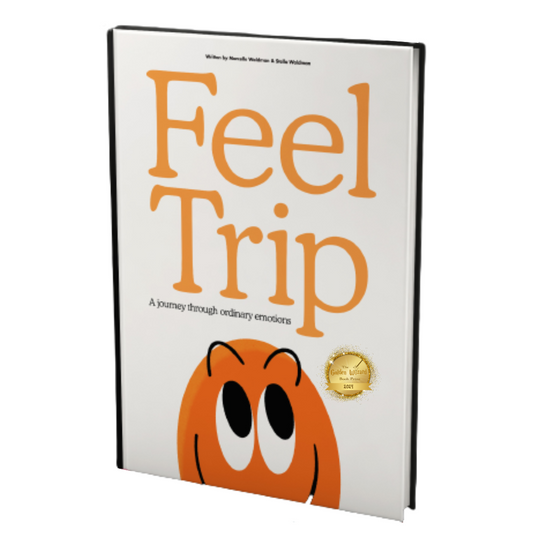Answering Tough Emotions: Reacting vs. Responding and Supporting Through Co-Regulation
Share
*Original blog written for HiMama can be found here. A few edit and changes were made for purposes of sharing with FeelLinks community.
I had the opportunity to present a webinar for HiMama's Weekly Webinar Series. I shared insights into what children experience in their brain when they are feeling tough emotions and what co-regulation strategies parents and educators can use to support a child in these moments. I discussed actionable ways to strengthen children’s social-emotional development and increase their confidence.
Watch the webinar that inspired this blog post here!
As educators, parents, caretakers, or healthcare professionals, we often experience children feeling their toughest emotions. Difficult emotions frequently come in tandem with challenging behaviors. When we are presented with a child's tough emotions or behaviors, there are two ways we can answer to them - we can either react or respond.
Reacting versus responding
Reacting is:
- Meeting someone’s actions with another action (often another tough action)
- Instant
- Survival oriented
- Can be a defense mechanism
- “Without thinking” or the unconscious mind
- Based in the moment
- Does not take into consideration long term effects
- Often be something you regret
Reacting does not work well when a child is experiencing tough emotions, thoughts, or behaviors. In most cases, it will not lead to calm for the child or the adult.
So, let's look to the alternative way of answering a child; responding.
Responding is:
- Derived from the word ‘responsibility’
- Calm
- Slow
- Deliberate
- Considerate of your own and others’ well-being
- “Thinking before you act” or taking information from both the conscious and unconscious mind
- Weighs long-term effects
- In line with core values
Turn to your “why” and core values when you experience a challenging situation with your child/student. Be the calm, trusting and responsive adult that your child needs.
We know that a child’s brain is not fully developed, therefore, they do not hold the capacity to handle such intense emotions well. We are going to be there to support them through a practice called, co-regulation.
Emotion co-regulation
Co-regulation is a supportive, soothing process between an adult and a child. Your affect, gesture, and tone matter. It is our responsibility to show up to a child with calm, empathy, validation and support. We must explicitly teach regulation through countless amounts of modeling and practice.
Co-regulation builds:
- Compassion
- Patience
- Trust
- Safety
- Feelings of belonging
How do you support through co-regulation?
It starts with ourselves learning how to regulate our own emotions in order to co-regulate with a child effectively. Self-care is an important factor for us to be our best-selves for our children/students. When we approach a situation with a child experiencing heightened emotions, we need to respond with a calm, warm demeanor, validation and empathy.
This might include:
- Anticipating needs
- Responding to cues
- Modifying the environment decreasing distress
- Teaching and re-teaching rules and expectations
- Teaching, modeling and coaching children to label their feelings
- Giving a child a hug, if desired
- Spending "time in" connecting through a choice activity
- Taking deep breaths together
- Listening to their feelings and thoughts and inviting them to problem-solve
- Physical or verbal prompting
- Creating calm down spaces with calming materials
- Providing opportunities for learning organizational skills
- Setting clear boundaries, rules and consequences
Show our children that even in the toughest of times, we can find calm, problem solve, and eventually move on. We want our children to feel our unconditional commitment to them.
“Emotions serve a purpose. They signal to ourselves what we need. They signal our values.” -Dr. Susan David
Co-regulation requires:
- A structured environment: physically and emotionally safe, predictable, with consistent routine, clear expectations, goals, and logical consequences.
- Teaching and coaching self-regulation skills: modeling, explicit instruction, practice, support, coaching, scaffolding, and successful use of new skills
- A warm, responsive relationship: caring, affectionate, trusting, responding with calm affect, words and actions, validation, respect, unconditional commitment, and empathy.
Please remember, in those moments when you react quickly, instead of responding calmly, as we all do, repair is extremely important. We hope that the children we are caring for learn repair from our modeling. We would like our children to repair with others they have wronged. Modeling is key!
Ensure you are teaching and talking about regulation skills with children when times are calm, as this is when learning is at its best.
Emotional self-regulation skills
Co-regulation is building towards the ultimate goal of emotional self-regulation. We want to raise children who can self-soothe and manage their emotions by responding instead of reacting. We want children to use what they have learned and what has been modeled for them.
Self-regulation is:
- Self-soothing
- Managing emotions and impulses
- Responding vs. reacting
- Ability to cheer yourself up after disappointments
- Acting consistent with values
- Success in relationships, home, school/work
Learning to self-regulate our emotions is an important life skill. Supporting children to develop these skills from a young age, sets them up for current and future successes in life – in school, work, relationships, and overall physical, emotional, and mental health.
Watch the webinar that inspired this blog post here!
“Our emotions signal things we care about. We tend not to feel strongly about things that aren't meaningful.” -Dr. Susan David
With Gratitude,
xo Marcelle






